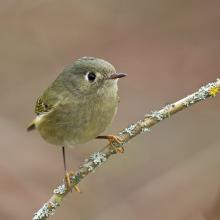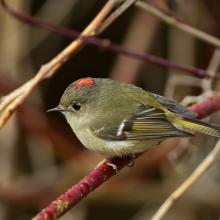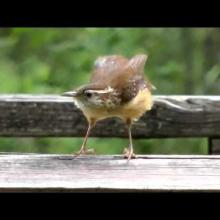

Join BirdNote tomorrow, November 30th!
Illustrator David Sibley and actor H. Jon Benjamin will face off in the bird illustration battle of the century during BirdNote's Year-end Celebration and Auction!
Some of the tiniest birds in the world have impressively loud voices. The Ruby-crowned Kinglet — that bright-headed sprite of the treetops — would be downright deafening if it were just a little bigger. Hummingbirds were originally named for the mechanical buzzing produced by their inconceivably fast wing-beats. But some males, such as this Costa’s Hummingbird of the Southwest, are equally notable for their vocal attainments. Late in winter, these tiny gems flash their purple throats and utter a startlingly loud, ear-piercing whine.
BirdNote®
Decibels Per Gram
Written by Rick Wright
This is BirdNote.
Birds are loud.
[Northern mockingbird, ML 197002, 01:05 ff.]
Sometimes it seems that the smaller the bird, the bigger the voice. Some of the noisiest species in the Americas are the wrens, their loud chants and trills all out of proportion to the slightness of those slender bodies.
[Carolina Wren, ML 196481, 00:52 ff.]
The Ruby-crowned Kinglet, too — that bright-headed sprite of the treetops — would be downright deafening if it were just a little bigger.
[Ruby-crowned Kinglet, ML 206445, 00:002 ff.]
Hummingbirds, of course, were originally named for the mechanical buzzing produced by their inconceivably fast wing-beats.
[Ruby-throated Hummingbird, ML 176299, 00:25 ff.]
But some males, such as the Costa’s Hummingbird of the Southwest, are equally notable for their vocal attainments.
[Costa’s Hummingbird, ML 125272, 00:49 ff.]
Late in the desert winter, these tiny gems take conspicuous perches on ocotillos and mesquites, where they flash their purple throats and utter a startlingly loud, ear-piercing whine, described by 19th-century naturalists as, “like the sharpest note … on a violin.” A male Costa’s Hummingbird weighs 3.6 grams, less than a tenth the mass of a mockingbird. Which given its voice is maybe just as well.
[Northern Mockingbird, ML 197002, 01:05 ff.]
Support for BirdNote is provided by The Hugh and Jane Ferguson Foundation — and generous listeners around the world.
###
Bird sounds provided by The Macaulay Library of Natural Sounds at the Cornell Lab of Ornithology, Ithaca, New York. Northern Mockingbird [197002] by Bob McGuire; Carolina Wren [196481] by Bob McGuire; Ruby-crowned Kinglet [206445] by Bob McGuire; Ruby-throated Hummingbird [176299] by Geoffrey A. Keller; Costa’s Hummingbird [12572] by Gregory F. Budney.
BirdNote's theme music was composed and played by Nancy Rumbel and John Kessler.
Producer: John Kessler
Executive Producer: Dominic Black
© 2016 Tune In to Nature.org November 2023
Narrator: Michael Stein
ID# sound-22-2016-7-26 sound-22









